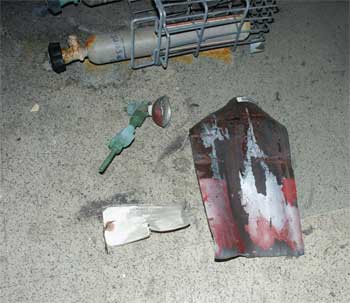Last Revised: February 16, 2018

Anhydrous hydrogen fluoride slowly reacts over time with the iron in the steel to form iron fluoride and hydrogen. The hydrogen pressure can ultimately build to the point where it ruptures the cylinder. The photo above shows the remains of a cylinder that ruptured as a result of this reaction.
This hazard was discussed in a 1997 alert in the American Chemical Society publication, Chemical & Engineering News. Chemical & Engineering News (28 Apr 1997) Vol. 75, No. 17, pp. 6.
There is a potential overpressurization hazard with the long-term storage of carbon steel cylinders containing liquid anhydrous hydrogen fluoride (AHF). AHF in such a cylinder reacts very slowly with the iron in the steel to form iron fluoride and hydrogen. The hydrogen collects in the vapor space and builds up pressure.
An AHF lecture bottle (DOT 3E) that had been in storage for as long as 14 years was found to be at an estimated pressure of 2,400 psig. After venting to a scrubber, the gas from the cylinder was found to be primarily hydrogen. Expected pressure, based on AHF's vapor pressure, would be between 5 and 15 psig.
Worldwide, there have been a few reported cases of AHF cylinders failing as a result of overpressure from hydrogen buildup after approximately 15 to 25 years of storage.
Facilities that have carbon steel cylinders containing AHF should not store these cylinders for extended periods without monitoring pressure and cylinder condition. Extreme caution should be taken during the handling of any AHF cylinders that have been stored for extended periods. As with any handling of HF, proper safety procedures should always be used (for example, protective equipment) and first aid supplies should be available in the event of personnel exposure.
All cylinders of anhydrous HF must be clearly dated upon receipt and discarded within 2 years.
The use of anhydrous HF gas also requires EHRS notification and a written Hazard Control Plan.
The following SOPs and Fact Sheets may relate to this hazard:
Hazardous and Highly Toxic Gases SOP
Lecture Bottle Safety Fact Sheet
Revised 3/2017